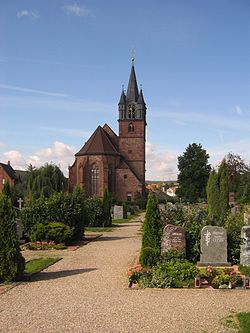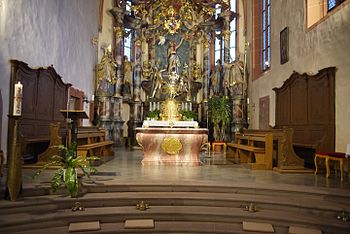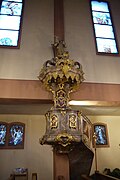St. Martin (Külsheim)
The Roman Catholic parish church of St. Martin (also Martinskirche ) in Külsheim in the Main-Tauber district was first built in 1497 with the help of the Archbishop of Mainz and is consecrated to St. Martin of Tours . In the 1960s, the church building was partially rebuilt, which still shapes the exterior of the church today. The Martinskirche belongs to the pastoral care unit Külsheim-Bronnbach, which has been assigned to the deanery Tauberbischofsheim of the Archdiocese of Freiburg since a deanery reform on January 1, 2008 .
History and church building
As early as the Middle Ages, the parish received the right to build a church through the Archbishop of Mainz, which it pursued with the first church building that existed until the 1960s. The first church building was built with the help of several wealthy donors, to whom the six coats of arms at the beginning of the vault ribs are dedicated. The choir of the church, which still exists from this time, still houses the high altar from the time the church was built, which the cabinetmaker Andreas Schmidt from Eussenheim and Georg Schäfer from Karstadt were supposed to create together. As can be seen from old chronicles, the well-known Würzburg sculptor Johann Peter Wagner was also partly involved in the work. What stands out on this altar is the rising figure of the risen Jesus with a victory flag in his hand. Equally impressive are the four statues on the left and right of Jesus, which depict St. Martin, St. John Nepomuk, St. Joseph and St. Boniface.
The tower of the church also has several special features, for example access to the tower is still only possible through a door with well-preserved Gothic fittings. There is also a Romanesque base bead from the period from 1150 to 1200 on the side of the choir under the tower. According to historians, this bead comes from an antechamber that is unfortunately no longer fully reproducible, but is not documented in writing. The loophole windows of the tower, which date from the years 1240 to 1250, are still preserved today. After several small renovations, the tower of the church was raised between 1920 and 1921, which still exists today in a similar appearance. A special feature that looks unusual, especially for strangers, is the steeple clock of St. Martin's Church, as it shows the time, visible from far beyond the city and on all four sides, but often shows different times.
After the immigration of a large number of displaced Christians after the Second World War , the parish decided to enlarge the nave of the church with the preservation of the sanctuary. During this renovation phase, the exterior and interior appearance of the church changed completely and the church, which was originally built in the Baroque style , was simply rebuilt with the help of many Külsheim citizens. Before the renovation, St. Martin's Church was provided with lateral galleries. Today's building is much simpler with a wooden coffered ceiling. A special feature of the converted church is its still existing front entrance with the stone relief of the patron of the church above the stone door frame, on which Saint Martin can be seen on a horse. With the renovation, the church also received a new main entrance consisting of two large wooden doors about three meters high. It is mostly only used on public holidays or for weddings, as a large staircase leads to the war memorial following these doors.
Since the renovation, the church has four entrances for the public and one direct entrance to the rather simple sacristy. There are two entrances in the direction of the rectory and one entrance in the direction of the fairground in front of the castle. Furthermore, the main entrance is oriented towards the city. The access to the sacristy is located at the rear of the church next to the chancel.
Furnishing
Choir and altars
In the chancel there is not only the new main altar, the high altar and the ambo, but also the old main altar, as well as four wooden benches for altar servers and lecturers, two of which come from the old church house and are richly decorated. Two of the pews are more modern in style, like the pews in the rest of the church. The church has three altars, only one of which is still in full use today. However, all altars continue to fulfill different tasks throughout the church year. The old main altar and the two side altars come from the old church.
New and old main altar
The new main altar is located directly in front of the old main altar in the background. Due to the past, in which the priests performed mass with their backs to the congregation, the re-erection of an altar with the priest's view towards the congregation was considered necessary as part of a renovation of the church.
In the old altar there is a relic of St. Martin. In addition, the new tabernacle and six candles, the number of which are lit differently depending on the day, have found their new location on the old altar. The altar is decorated with different flowers on different holidays.
In the newly erected altar, with a marble-like exterior paneling and a gilded, framed cross on the front, there is no relic of a canonized person. It has a small gilded wooden cross on its front. Often there is a small cross and three small candles on this altar, which burn for each Mass. After the reconstruction of the church, the entire altar was intended as a temporary measure, but like the ambo, it has been integrated into the church over time and is now considered normal by most church visitors.
Left side altar
The left side altar, which is dedicated to Saint Mary , stands behind the pulpit on the left side of the church. Mary holds the child Jesus in her arms and wears a gold-plated crown. There are also two more statues on the respective sides of the altar, as is the case on the right side altar. Every year at Christmas a small electric church is built on this altar, which shows a 30-second representation for the younger worshipers, but also for visitors after the mass for a small amount. Likewise, during Advent, a nativity scene is set up on the area to the left of the altar , which recreates the stable of the birth of Jesus Christ. It is made entirely of wood and was first erected at the end of the 20th century.
Right side altar
The right side altar is the most sacred heart of Jesus. This altar has two other statues. Every year between Maundy Thursday and Easter Vigil, the hosts are kept in the tabernacle it contains and brought to the main altar in a small procession with the sound of two wooden clovers . In addition, the baptisms , which usually take place on Sundays in the church, are held on him, which is a good position for the baptism ceremony due to the proximity to the benches.
Church longhouse
The roughly 35 meter long nave of the church has, in addition to the simple wooden benches, a baptismal font, a Jesus cross, a pulpit and gallery with an organ. There is a red carpet in the central aisle of the nave.
Baptismal font
Today's baptismal font was taken over from the old church. It is carved from stone and covered with a copper lid when not in use. The baptism of Jesus is depicted on the copper lid.
Relic of St. Nicholas of Flüe
In the corner behind the baptismal font is a relic of St. Nicholas of Flüe in wood. On the left there is also a figure of the saint with his wife.
Crucifixion group
A special feature of the church, which was preserved even after the church was rebuilt, is the crucifixion group now hanging on the right side wall of the church. In the original church, the motif hung on the left, in the middle of the church below the gallery that was then present. The body of Christ is shown stretched out on it. The pathetic nature of the apostle Johannes in this regard is reminiscent of the crucifixion group in the high altar in Nördlingen .
pulpit
The pulpit, which also comes from the old church, was decorated by a sculptor from Karlsstadt in the Rococo style. The sound cover is adorned with a statue of a good shepherd and in times of the old church the symbols of the four evangelists were still attached to the lower edge of the pulpit.
Only rarely used today, the pulpit was a large part of the church and sermons in the early years after the renovation. For some years now, however, people have only preached and read the Gospels from the ambo next to the new main altar.
organ
As part of the reconstruction of the church, the old organ was also removed and a new, larger organ by Orgelbau Vleugels from Hardheim was inaugurated. On it are two angels and a statue of St. Cäcilia, which was removed from the chapel by the three-bowl fountain in the city center of Külsheim.
Bells
The parish church of St. Martin has a four-part bell:
| No. |
designation |
Caster |
Casting year |
material |
Ø (cm) |
Weight (kg) |
Nominal |
|---|---|---|---|---|---|---|---|
| 1 | Sacred Heart Bell | B. Grüninger, Neu-Ulm | 1949 | bronze | 122.0 | 1,200 | e 1 - 1 |
| 2 | Marienbell | B. Grüninger, Neu-Ulm | 1949 | bronze | 98.0 | 600 | g sharp 1 - 1 |
| 3 | Joseph Bell | Ulrich foundry, Apolda | 1921 | bronze | 85.0 | 385 | h 1 - 4 |
| 4th | Martin's bell | B. Grüninger, Neu-Ulm | 1949 | bronze | 71.5 | 250 | c sharp 2 - 1 |
Mount of Olives
Outside the church on the south side of the choir there has been a mount of olives since 1497, which represents Christ with three of his disciples in the form of wooden figures. No longer visible today, there was probably a painted Mount of Olives landscape with Judas behind the image in the early days of the church.
literature
- City of Külsheim (Ed.): Stadtbuch der Stadt Külsheim, 2006.
- Franz Gehrig, Hans Kaulartz and Herbert Maring (eds.): St. Martin Külsheim . Catholic rectory in Külsheim, 1987.
- Elmar Weiss, Irmtraut Edelmann, Helmuth Lauf (authors): History of the well town of Külsheim. 2 volumes. City of Külsheim (ed.). Tauberbischofsheim, FN Druck 1992. Volume 2. With contributions by Pastor Gehrig, Herwig John, Günther Kuhn. Pp. 39-53 and 60-69.
Web links
- Homepage of the pastoral care unit Külsheim-Bronnbach on the website kath-kuelsheim-bronnbach.de
- Catholic parish church St. Martin (Kirchbergweg 24, Külsheim) on the website www.leo-bw.de
- View of the castle and church on the website kuelsheim.blogspot.de
- Church extension St. Martin 1954 on the website kuelsheim.blogspot.de
- Interior view of the Church of St. Martin before the renovation on the website kuelsheim.blogspot.de
Individual evidence
- ↑ Catholic parish Külsheim: Külsheim-Bronnbach . Online at www.kath-kuelsheim-bronnbach.de. Retrieved December 9, 2016.
- ^ Deanery Tauberbischofsheim: Pastoral care units of the Deanery Tauberbischofsheim . Online at www.kath-dekanat-tbb.de. Retrieved December 12, 2016.
- ↑ a b c d Franz Gehrig, Hans Kaulartz and Herbert Maring (eds.): St. Martin Külsheim (page 5). Catholic rectory in Külsheim, 1987.
- ^ A b Franz Gehrig, Hans Kaulartz and Herbert Maring (eds.): St. Martin Külsheim (page 9). Catholic rectory in Külsheim, 1987.
- ^ Church extension St. Martin 1954 . Online at www.kuelsheim.blogspot.de. Retrieved December 16, 2016.
- ↑ a b Spengler: Interior of the St. Martin Church before 1950 . Online at www.kuelsheim.blogspot.de. Retrieved December 9, 2016.
- ↑ a b c Franz Gehrig, Hans Kaulartz and Herbert Maring (eds.): St. Martin Külsheim (page 7). Catholic rectory in Külsheim, 1987.
- ↑ Heribert Engist: Messner St. Martin Church (call in December 2016).
- ^ A b Franz Gehrig, Hans Kaulartz and Herbert Maring (eds.): St. Martin Külsheim (page 11). Catholic rectory in Külsheim, 1987.
Coordinates: 49 ° 40 ′ 14.2 " N , 9 ° 31 ′ 20.9" E








